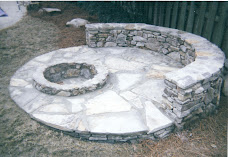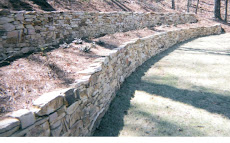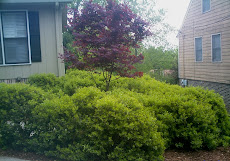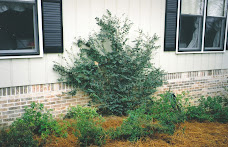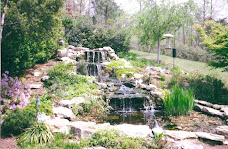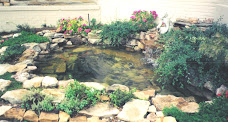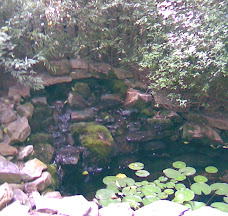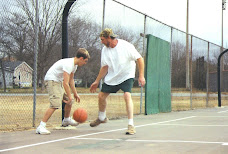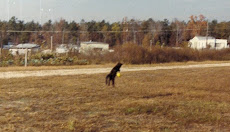Saturday, December 27, 2008
Merry Christmas and Happy New Year!
Posted by
themanfromearth
at
12:38 AM
0
comments
![]()
Labels: Rob's musings
Thursday, December 11, 2008
Parking Pad/Pathway Job Walk Through
The last couple of weeks or so, in between rain and cold (for Alabama), I've been in Homewood working on the installation of a parking pad, flagstone walk, and a stepping stone path.
The objective, initially was to find a spot for a car new to the family. Yes, a teenage driver (insert Bates Motel music)!!!
We decided to surface the pad with an 8910 gravel which was chosen because of the particular quarry it came from. This gravel has a slightly tan color and is not as stark as the typical gravel you buy from suppliers. Also, using 8910 gravel, which will pack down and offer an excellent surface for parking, is economical, and at the same time, attractive and functional.
The parking pad was bordered, on the lawn side, with a stone soldier course. Those stone, most of which are exposed 3 inches above the grass line, have nine plus inches buried and surrounded with cement and mortar. Careful attention was used in selecting the soldier course stone so that, one, the colors matched with the walkway, and two, that the length and thickness of the stone fell in place with the over all scale of the entire project.
The flagstone walkway was installed using a combination of stepping stones that were previously used for traffic from the drive to the front door and from stones the homeowner had left over from previous work on the house. Using the two different types of stone actually made for an interesting combination that worked well together.
The stepping stone path was chosen to provide access from the pad to the front door. As usual, I tried to steer away from straight lines, trying to make the pathway seem more "organic".  PHOTO: Crimson Queen Japanese maple
PHOTO: Crimson Queen Japanese maple
Finally, a planting bed was created at the head of the parking pad to help direct foot traffic and help soften the over all project. The homeowner has already bought a 'Crimson Queen' Japanese Maple to plant in the bed. It should really enhance the entire job.p
Posted by
themanfromearth
at
9:44 PM
0
comments
![]()
Labels: deciduous landscape plants, patios and walkways, project showcases, stone work, video clips
Friday, November 21, 2008
Website review: monrovia.com
If you are like me, you have an appetite for good sources of information on plants. What is their hardiness rating? What new varieties are available for purchase? Hey, what does it look like!? These and many more questions come to mind. One of the better Internet sites I've found to answer these questions and more is monrovia.com.
Monrovia is a wholesale container nursery that was started in 1926, by Harry Rosedale. The first nursery was located in California, although, now they have nurseries as far east as Georgia. I can remember back in my early nursery days in the late 70's that Monrovia was synonymous with quality and innovation, and they still are today.
So, on to the site! The web site is divided into four sections, Inspiration, Design, Learn and Community.
The Inspiration section has interesting features that include a "style quiz" that helps to give you a sense of what type of garden you'd really enjoy as your personal outdoor environment.
In the Design section of the website, you'll find tips on landscape design and a helpful "how-to video". The "how-to video" was well done and relevant to the season of the year.
Learn is broken down into six categories: soil story, plant catalog, new plants, gardening basics, zones and resources. Lots of good info here, particularly the resources area where you'll find a bunch of interesting links, but the main reason for visiting monrovia.com is the plant catalog and new plants portion of the Learn section of the website. Monrovia's catalog is vast and detailed. If you have a particular plant in mind that you want to get information on, you can simply access that info from the search engine at the top left of the home page, but it you are searching for advice on what might work in a specific situation, then use the searches in the plant catalog and new plant section of Learn. There are lots of ways to narrow your search using those two engines, but I'll warn you in advance not to put too many criteria in place when performing the search or you'll get zero matches. Once you find a plant, you are rewarded with fine photographs of the plant, plus info on light needs, mature size, etc. 
PHOTO: Just one of hundreds of photos you'll find at monrovia.com. This one is Viburnum Opulus 'Aureum'
Community gives you an opportunity to develop a personal profile and participate in online forums, read blogs, and subscribe to a newsletter.
In conclusion, monrovia.com is a fun site with a lot of interesting and helpful places to visit in the site. It's plant search engine is a good way for you to get suggestions on what to plant in a specific spot in your yard and if you have a specific plant in mind, you can get some good info on that plant and perhaps find some closely related new varieties, as well. Rob's 5 star rating guide for monrovia.com: ****1/2 (4.5 stars)
Posted by
themanfromearth
at
5:18 AM
1 comments
![]()
Labels: Rob's musings, web site reviews
Wednesday, November 5, 2008
When is it a good time to plant shrubs and trees?

This is a question I get asked from time to time and like many in my profession, I have my opinions. The criteria I am going to use for ranking months to plant woody shrubs and trees is survivability. Planting a large tree in scorching July heat, for instance, could be so stressful that a tree could perish with less than optimum care. So here are the rankings, from worst to best:
#11 and #12 - July and August - I wouldn’t suggest planting woody shrubs or trees in these two months. July is the hottest month in Central Alabama with an average high of 91 degrees; however, it can be a wet month, averaging a little over 5” of precipitation a month. August might be a little more tempting of a month due to its closer proximity to fall, but with an average high temperature of 90 degrees and it being the second driest month, with less than 3.5” of rain, on average, it is just as unsafe a month to plant in as July is.
#10 - June - Spring has sprung and summer is gaining momentum. Don’t get fooled by a few pretty days. With average high temps of 88 degrees and an average monthly rainfall of 3.78 inches (third worst month), June offers little upside for planting things like forsythia, maple and other shrubs and trees.
PHOTO: Red Sunset maple
#8 and #9 - May and September - Neither is an awesome month to plant in, yet neither is off limits. If the subsequent care (especially watering) of the plants being considered for installation is going to be good, I will plant them. Both of these months average over 80 degrees. September is a slightly drier month than May, but September is closer to fall (a very planting friendly season), so it’s a draw between these two.
#7 - April - I know. I know. That is a month when nurseries are bursting with folks looking for things to plant. Well, there are two things to consider. One, those people aren’t well informed….just kidding, haha. One, many of those people are looking for annuals and perennials to plant and my list is for woody shrubs and trees. And two, April is just two and a half months removed from the summer season. I’m not saying this is a bad month to plant in; it is a good month to plant in, just not the best.
#6 - March - March is a very fine time to plant. With an average high temp of 66 degrees and the wettest month of the year, March is plant friendly. But there are even better months ahead!
#4 & #5 - December and January - I love planting in December and January. These months would be ranked higher if not for the disclaimer I need to provide for them. Disclaimer: I would "consider" excluding plants with a zone hardiness rating of 8 or higher (some examples would be oleander ,pittosporum, or some varieties of gardenia), because of their susceptibility to cold damage. Don't let the disclaimer scare you off, though. Put on your long johns, grab a shovel, and plant your sweet shrub and dogwood, knowing they are loving you for caring enough to find them a new permanent home at the right time of the year.
PHOTO: Sweet shrub (fragrant, deciduous flowering shrub)
#3 - October - Why isn’t October #1 or #2? Well, it gets edged out because it can still be rather warm in October and it’s typically a dry month (the driest on average of all the months, averaging just 3.23” of rain). Still, fall has just begun and you’ve got all of this great root growing season ahead of you (fall and spring are the seasons when roots grow the most), plus the mild Alabama winter and then spring greet us before the harsh summer whacks us upside the head. October is a winning month for planting, for sure.
#2 - February - This is a great time to plant. Root growth is occurring. Deciduous plants haven’t leafed out, yet, reducing the amount of transpiration (water loss), which can stress a plant out. Yes, February is a wonderful time of the year for getting in your hydrangeas, magnolias, and other such flora. If not for the fact that February is less than four months away from summer, it would probably be #1. But forget that! It’s a totally awesome month to dig in. Can you dig it?
Ta,,,ta,ta,ta,ta,ta,taaaaaa!
#1 - November - This is the best of all the months to plant in, with February and October following close behind. November features an average high temperature of 65 degrees and is in the top half of rain producing months. The root growth of the plants you are planting will be through the roof and you have plenty of time before mean ol’ summer arrives. 
PHOTO: Grancy gray beard (small tree or large shrub)
If you notice, the three worst months to plant in are in the summer. Heat does not blend in well with planting shrubs and trees. It can be done, but as you see, there are better times of the year. I really don’t have a problem with any of the other nine months for planting, but some are just a little better or a little worse than the other. It’s Novermber, now, so if you’ve got a little snowball viburnum or Grancy gray beard that you’re think of planting, there couldn’t be a better time than now!
Posted by
themanfromearth
at
10:39 PM
2
comments
![]()
Labels: landscape tip, Rob's musings
Friday, October 10, 2008
Transform a ho-hum bed into something more
Have you ever noticed how a flower bed can start to lose its appeal? Grass and weeds begin to creep in and take up residence with the plants. Some of the plants just aren't performing as well as they could. Oh, woe is the gardener that confronts such a situation with little time and even less money (the DOW was down again) to do something about it. 
Recently, I encountered just such a situation at a very nice couple's home in Homewood. The bed on the back side of their home was divided into two or three sections. Some of the beds had loosely arranged rock borders, where the rock was basically sitting on top of the ground, and other beds had no rock border or delineation at all. Bermuda grass, the scurge of flower lovers, had found its way into much of the garden space, as well.
The recipe to upgrade this garden didn't take much time or expense. 
The formula for this situation:
1. With a can of spray paint, I played around with some curved lines for the bed outline, letting some of the plants that were already planted dictate how far out from the brick the beds would extend.
2. Once the outline was determined, weeds and Bermuda grass were sprayed.
3. Using the stone that was already there and adding a little bit more (from my own personal pile!), the border was installed. Nothing fancy, here. Much of the stone was dug up over the last couple of years, right there on the property. Tip: When installing a stone border, try standing the stone on edge, buried a few inches and then tamped in, to get more mileage out of your resources.
4. After installing the border, a soil mix was added to the bed. A few plants were raised so not to be planted too deeply and ferns, hosta, peonies, and few other fun flora were divided and replanted (dividing plants, a great way to take up garden space).
5. Where appropriate, landscape fabric was installed to keep weed re-emergence to a minimum. And finally, mulch was applied. 
To make this little project work, three things were essential.
1. A design that the client was happy with.
2. Proper installation techniques (in the case of this project, that would be plants and stone).
3. Maintenance (don't let weeds go unattended, mostly).
These three components are the keys to any successful landscape project. DESIGN, INSTALLATION and MAINTENANCE.
Posted by
themanfromearth
at
5:31 PM
0
comments
![]()
Labels: landscape tip, project showcases, stone work
Thursday, September 25, 2008
Consider your hardscaping before going soft.

When ever I talk to a client about a landscape project, one of the first things I mention (if the client hasn't) is, "will there be a need for hardscaping?". My definition of hardscaping is any non-movable element in the garden. Of course, plants and turf grow, so they are considered softscaping.
PHOTO RIGHT: Pondless waterfall
Hardscaping would include walls, walkways, ponds, bird baths, driveways, garden art, steps, etc. The reason I ask about hardscaping is because it's always a good idea to do that phase of the landscaping first to make the entire project go more smoothly.
PHOTO RIGHT: Wall with waterfall incorporated.
These photos and video are of a project I've been working on. I'm done with the major hardscaping and have done very little softscaping, so the results look a little unfinished until I get some fall plantings, possibly a few well placed mini-boulders, and a stone bench installed.
PHOTO BELOW: Stepping stones are considered hardscaping.
ABOVE: Video of pondless waterfall.
Posted by
themanfromearth
at
10:39 PM
0
comments
![]()
Labels: patios and walkways, ponds, stone work, walls
Monday, September 15, 2008
Informal steps
Sometimes you have a pile of mismatched stone, a hill, and a need. While that may not be an occurrence that you have ever been faced with, it is actually one I encounter at least once a year. 
A few years back, I took some irregular natural stone and various pieces of flagstone and put together this set of informal steps. It's not always the way to go, but in some instances, a set of steps that mildly twist up an incline (especially when surrounding area is planted with interesting flora) can be a positive addition to the landscape.
Posted by
themanfromearth
at
7:19 AM
1 comments
![]()
Labels: patios and walkways, stone work
Thursday, September 4, 2008
A Beauty of a Berry
 PHOTO ABOVE-Callicarpa americana
PHOTO ABOVE-Callicarpa americana
I have several memories of specific plants that go back to before I actually thought plants and nature in general would become a big part of my livelihood. One of those memories goes back to when I was a young teen. I remember spending some time at Logan Martin Lake, near Pell City, AL, with my family on the weekends. I enjoyed walking the woods that stretched above the banks of the lake, checking out all manner of interesting flora and critters. American Beautyberry is a plant that I remember growing in those woodlands. How could you not notice those striking purple berries in late summer or early fall? There simply isn't another native plant quite like it. I find beautyberry to be a plant that should find a home in many yards, as well. The plant is native throughout the Southeast and growing it here in Alabama shouldn't be a problem. I have found that growing Callicarpa (the genus for beautyberry) is relatively easy. It isn't particularly finicky when it comes to soil type, sun exposure, or moisture requirements. If you happen to live South of Birmingham, and especially if you live South of Montgomery and into Florida, you may just find your beautyberry to be quite the spectacle. While vacationing in the panhandle of Florida, several years back, I noticed several native beautyberry growing magnificently. I suspect beautyberry enjoys the warmer surroundings, even though it is listed as a Zone 5 plant.
While American beautyberry (scientific name, Callicarpa americana, also known as purple beautyberry) is probably the most familiar of Callicarpa species in these parts, there are other species to note:
PHOTO RIGHT-Callicarpa dichotima - a more compact plant than Callicarpa americana and is known to produce more berries, as well, but that may be more due to it's compact nature.
PHOTO LEFT-Callicarpa japonica 'Leucocarpa' - often described as "rare", this plant does have an unusual trait; it's white berries.
Most beautyberries grow to a height of around 4' to 6'. They are deciduous and they bloom around mid June to mid July. The blooms are not particularly ornate, but the plant makes up for its lack of flower power with plentiful and colorful berry production. Beautyberry will bloom and produce berries on new wood, so I would encourage you to cut any plants in your yard each spring. I've just touched on two or three Callicarpa species, but there are several more and dozens of varieties.
Posted by
themanfromearth
at
11:13 PM
1 comments
![]()
Labels: deciduous landscape plants
Monday, August 25, 2008
Conserving Water .... a couple of ideas.

UPDATE:
A few days ago I met with a very nice couple that I've done work for in the past. I thought it was really quite neat to see that their daughter had hand painted a rain barrel at the front corner of their home to help irrigate some plants in their back yard. I think she did a great job, don't you?
ORIGINAL POST:
Our cities grow and the demand for water increases. Many people love their plants. They are like friends to them. During the last few years, there have been instances where city governments have placed restrictions on outdoor watering. When outdoor watering is restricted, we are making it hard for our plant friends to be all they can be. One way to help is homemade water conservation.
Water Barrels - Connect to your roof gutters and direct year-round rainfall into these durable collection barrels. These barrels range in price from $60 - $150.
A link to "How to make your own water barrel:
http://www.bayteccontainers.com/howtomaraba.html
Here are a few more ideas that might help with water conservation:
You can do many things to capture rainfall at your site:
-Create depressions around trees and line them with rocks or mulch to retain moisture.
-If you are designing a new home site for water harvesting, arrange brick or flagstone paving to direct water to plants.
-Dig furrows and channels to direct water to a garden.
-Make sure your gutters and downspouts are free of trash, dirt and leaves.
Posted by
themanfromearth
at
6:26 PM
3
comments
![]()
Labels: landscape tip
Sunday, August 17, 2008
Stone mailbox




VIDEO ABOVE
I really enjoyed doing this job. It was my first stone mailbox and my clients felt comfortable with me doing the work. Just about the entire time I was working on this project, the homeowners were out of town. I was told that the lady of the house closed her eyes and she and her husband drove up. "How does it look?", she asked her husband. All is well. The homeowners are pleased and, of course, that is very important to me.
Posted by
themanfromearth
at
12:33 PM
0
comments
![]()
Labels: stone mail box, stone work, video clips
Wednesday, August 13, 2008
A fall wall?
Do you feel the hint of fall in the air? I do! At least, I think I do. I hope it's not a mirage. As the summer winds down and footballs begin to penetrate the air, I find myself in the middle of a couple of projects. One is a stone mailbox and the other is a backyard stack wall. Here are some pictures of the wall I'm building. I'll be sure to provide photos of the finished project when I'm done. Photos of the mailbox are forthcoming.  PHOTO LEFT: Here's part of the wall I'm working on, including some of the tools of my trade (shovel, hand mattock, rubber mallet, small sledge hammer, rock hammer...level and chisel missing in photo).
PHOTO LEFT: Here's part of the wall I'm working on, including some of the tools of my trade (shovel, hand mattock, rubber mallet, small sledge hammer, rock hammer...level and chisel missing in photo). PHOTO LEFT: One aspect of putting this wall together was removing the artificial segmented stones and redesigning the wall. The stone used is a mixture of various types of stone already on the property.
PHOTO LEFT: One aspect of putting this wall together was removing the artificial segmented stones and redesigning the wall. The stone used is a mixture of various types of stone already on the property.
Posted by
themanfromearth
at
10:56 PM
0
comments
![]()
Labels: stone work, walls
Wednesday, August 6, 2008
Circular patio with fire pit and sitting wall
 Me and my trusty pick-up found our way to Trussville, recently. I met a very nice family there that was interested in having a round patio with a firepit and sitting wall. They explained to me that the round shape of a patio would contribute a calming effect to those who used it. I have to admit, I do feel a calm pass over me when I sit on that patio, now that it is completed. The line of a circle is so simple, yet beautiful, you know. It's no wonder it can bring about serenity and convergence.
Me and my trusty pick-up found our way to Trussville, recently. I met a very nice family there that was interested in having a round patio with a firepit and sitting wall. They explained to me that the round shape of a patio would contribute a calming effect to those who used it. I have to admit, I do feel a calm pass over me when I sit on that patio, now that it is completed. The line of a circle is so simple, yet beautiful, you know. It's no wonder it can bring about serenity and convergence.
VIDEO: Circle Patio
Posted by
themanfromearth
at
9:03 PM
1 comments
![]()
Labels: bench seating, fire pit, patios and walkways, project showcases, stone work, video clips, walls
Thursday, July 31, 2008
Crocosmia - A hummingbird lovin', summer color perennial that will easily grow in your yard
It is this time of the year; hot and humid, sticky and sweaty. Being out in the yard during July and August can wear on you, but being around a plant in flower can make it more pleasant. Compared to spring and early summer, there aren't as many plants blooming in mid summer that can engage you and divert your attention from mosquitoes and the 100+ heat index. One such plant is the little used Crocosmia. PHOTO LEFT: Crocosmia will definitely attract hummingbirds and butterflies
PHOTO LEFT: Crocosmia will definitely attract hummingbirds and butterflies
Crocosmia are actually from the Iris family. They are perennial and grow from corms (bulb shaped roots). The foliage is somewhat gladiola-like, but the foliage isn't why you plant Crocosmia
The Crocosmia I have in my yard just started blooming in the last couple of weeks. These plants are not on my regular watering route, yet they grow and bloom, every year, without fail. Crocosmia blooms are typically orange or red. Mine are orange and really stand out because the hue is bright and solid. PHOTO ABOVE: Crocosmia 'Lucifer'
PHOTO ABOVE: Crocosmia 'Lucifer'
There are several Crocosmia varieties to choose from including Lucifer (red, of course), Bright Eyes (orange w/ red throat), Emberglow (orange red), and Babylon (deep reddish orange). These varieties and others also vary in bloom size, plant size, etc.
PHOTO RIGHT: Crocosmia 'Babylon'
What else is there to know about Crocosmia? They are notorious attractors of hummingbirds and butterflies. They're easy to divide and move throughout your yard or give away. They make great cut flowers. Crocosmia usually fall in the Zone 6 to 10 range, making them perfectly suited to our Southeastern climate. Try to plant them in full sun ot part shade and avoid particularly wet areas. Spring is a great time to pick up Crocosmia from your local nurseries. I can't say that I have seen it at the big box stores, so give the real nurseries a call and see what they have. Give it a whirl!
Posted by
themanfromearth
at
11:57 PM
0
comments
![]()
Labels: perennials
Wednesday, July 23, 2008
Do not scroll down if you have a bad case of arachnophobia
Grand Daddy Long Leg Convention
PHOTO ABOVE: Click on photo for an enhanced view.
Thank you, Linda, for taking this awesome picture of these spiders enjoying the shade of fig leaves.
Posted by
themanfromearth
at
10:29 PM
0
comments
![]()
Labels: Rob's musings
Thursday, July 17, 2008
Recommended Quick Trip...

PHOTO LEFT: Here is a shot I took of the Horton Mill Covered Bridge, located just a few miles down the road from the Oneonta Wal-Mart
If you just happen to be in the area or want to make a day trip out of it, Oneonta has a lot to offer... for such a small town. There are several covered bridges in Oneonta that you can visit. As for driving across them, I'm not sure about that. I do remember driving across the Horton Mill Bridge several years ago. I had my son, Jake, along for the ride the last time I crossed over the bridge and I have to say, it was exciting, scary, and nostalgic, all at the same time.
VIDEO ABOVE: Would I have driven across the bridge if it hadn't been roped off? Sure, adventure is my middle name!
One block off of main street, there are several cool shops where you can browse local folk art (Donna and I are the proud owners of a beautiful brown hand made fruit bowl that we purchased a few years back), antiques, old time hardware, and more. And there are more than just a few good eateries around town that will satisfy any craving you might have.
A few miles outside of Oneonta, you can visit Palisades Park. There are some awesome rock outcrops and bluffs there. Palisades Park is a great place to go rappelling or simply take in the awesome scenery.
If rock peaks your curiosity, stop in at one of the many stone companies located in Oneonta. You can kill a half hour or more just dreaming about what you could do in your yard with a pallet or two of rock.
For more information on Oneonta and Blount County, try this web site: http://www.blountoneontachamber.org/
Posted by
themanfromearth
at
8:09 PM
0
comments
![]()
Labels: Recommended Quick Trips
Tuesday, July 8, 2008
New Photos from Judy
 The use of garden art, containers and well placed perennials
The use of garden art, containers and well placed perennialsis a good way to soften stone work.(Click on the picture for a closer look)
About a couple or so years ago, I met Judy and Johnny about doing some work at the home they were building in Shelby county. I ended up building a wall around their parking pad area (actually, the wall came first) along with steps and a flagstone walkway. I also dug up some of Judy's plants from the home she previously lived in for her to plant at her new home. It wasn't long before I became keenly aware that Judy had a wonderful touch with plants...she's quite knowledgeable and has a great eye!
Judy was nice enough to send me some updated pictures of the work I did at their home along with all the landscaping she has done herself to make it all look so much nicer than it did those two years ago when I mortared in the first stones. I'm thrilled to see how she's made the whole area really flow. I hope you enjoy the pics and here is a link to see what it looked liked before Judy's eye took over - http://themanfromearth.blogspot.com/2008/01/stone-and-brick-can-work-together.html
 A long, pretty drive leads up to Judy and Johnny's home.
A long, pretty drive leads up to Judy and Johnny's home.
Posted by
themanfromearth
at
5:15 PM
0
comments
![]()
Labels: bench seating, patios and walkways, stone work, walls
Wednesday, July 2, 2008
My brush with fame....
It's a stretch, I know. My buddy, Jimmy Rockett of Bug Juice Gardens on Shelby Hwy 43, does a television spot on gardening every Wednesday on FOX 6 and today he did a spot on ponds and waterfalls. The pond he featured? It was one I built about 5 years ago. Here's the link:
http://www.myfoxal.com/myfox/pages/Home/Detail;jsessionid=A96D00BB407E6279B0A21F9C7C38D46B?contentId=6895094&version=1&locale=EN-US&layoutCode=VSTY&pageId=1.1.1&sflg=1
(my blogspot "insert a link" option isn't working for me, so you can simply copy and paste this address to your browser, and it will take you to the video)
Thanks Jimmy! You did a great job!
Posted by
themanfromearth
at
7:30 PM
0
comments
![]()
Labels: ponds, video clips
Wednesday, June 25, 2008
Water through a wall
A client of mine had a retaining wall built along the back of his house and he left a 5 or 6 foot wide hole in the wall for me to put a water feature in. Sorry about the video quality...I kind of just wanted to see if the video feature from my phone (I've only dropped my phone into a pond once, so far) could make it to my garden blog.
As for the noise at the end of the video clip...my wife, Donna asked, "is that your stomach?" No, it isn't! Ha Ha Ha!
Posted by
themanfromearth
at
7:35 PM
0
comments
![]()
Labels: ponds, video clips
Friday, June 20, 2008
Purple Cone Power!
No, I meant to say power...the flower with power! The power to lure you closer for a look see; urging you to say out loud, "Wow! I love your purple coneflower!". Ooops, sorry I was getting a bit over dramatic, there. 
But indeed, purple coneflower (Echinacea purpurea) is an eye catcher, and on my scale of "easy-to-grow" perennials, purple cone flowers rate pretty high. They like full to part sun and a nice, well-drained soil. I really like the idea of working organic matter such as soil conditioner or even bagged top soil into the the area I'm planting purple coneflower to a depth of 12" (or more, if the soil is compacted). After they become established, purple cone flowers are pretty drought tolerant.
Once planted, dead heading the first batch of blooms, which first appear in mid-June to early July, will likely lead to some extra blooming later in the summer. If the situation is right, you'll find purple coneflower to reward you by spreading to form a nice colony of plants that will make a great show in your garden for years to come and also allow you to dig up some to move to another locale. By the way, purplecone flowers really attract butterflies!
Finally, extracts from Echinacea are said to provide valuable medicinal properties. All parts of the plant, including the roots, leaves, flowers, seeds, etc., have been used to treat a variety of ailments. It's a very popular plant amongst herbalists.
There are quite a few varieties of Echinacea purpurea that you may want to try:
'Magnus' purple cone flower (photo,right)
'Magnus' - 1998 Perennial Plant of the Year. Large, 6 inch rose-magenta flowers with petals that are more horizontal, rather than than the pendulous nature you see quite often in seedling purple coneflower.
'White Swan' - An Echinacea with white petals. I've found it just as easy to grow as the species and varieties such as Magnum.
'White Swan' Coneflower (photo, right)
'Evan Saul' - A non-purple purple coneflower! This cone flower came from a nursery in Atlanta, GA, as a result of some cross pollination between E. purpurea and E. paradoxa. It is said to be a vigorous grower. I have not, as of yet, seen it available in our local nurseries.
'Evan Saul' Coneflower (photo, left)
Posted by
themanfromearth
at
7:05 AM
0
comments
![]()
Labels: perennials
Saturday, June 14, 2008
Five woody landscape plants to possibly avoid in your landscape
There are some woody landscape plants that enjoy popularity but probably should be given careful consideration to before planting them in your yard. My criteria for a plant making this list isn't so much about insect and disease vulnerability, although that may be part of it, but more about how attractive and reliable the plant is, long term, in your landscape. This is my opinion based on years of observation. It's certainly a subjective opinion and if you've got any of these plants in your yard and you love them....my apologies! My list of five are (in no particular order):
5. Any Japanese holly. Scientific name - Ilex crenata. Helleri holly and Compacta holly are two that are commonly sold in nurseries (there are many!) that I have seen more dead or dying than doing well. Be sure, when buying a small leaf holly that doesn't have thorns, to look and see what the scientific name is. If it begins with Ilex crenata, you're probably going to regret your purchase. I suspect that Japanese holly is simply a plant that requires excellent soil conditions coupled with a consistent watering regiment (something, especially given the periodic outdoor watering bans, that isn't likely to occur in most landscapes over the long haul), but numerous other problems, such as web blight, anthracnose and canker problems have been linked to Ilex crenata, as well. An excellent common landscape plant to use as a substitute for Helleri, Compacta, and other Japanese hollies is Dwarf youpon holly (Ilex vomitoria 'nana'). Ilex crenata 'Compacta'
Ilex crenata 'Compacta'
(photo left) Bradford Pear Damage (photo, right)
Bradford Pear Damage (photo, right)
4. Bradford Pear. Makes the list based on two main factors. One, it is overused in the Southeast. Two, it is a very weak wooded tree and with age, becomes as brittle and breakable. I remember taking a woody plant course at Auburn, back in the 70's, and this tree was touted as having ornamental pluses for all four seasons of the year. The tree hadn't been used nearly as much in the landscape back then as it has been in the last two decades and some of the pitfalls of having a Bradford in your yard weren't as publicized back then. More recently, its use has declined quite a bit. In fact, in some new residential developments, it is banned from being planted. Nandina domestica 'Firepower' (photo, left)
Nandina domestica 'Firepower' (photo, left)
3. Dwarf Nandina 'Firepower'. I'm not including some of the neat prostrate hybrids out there, like Harbour Dwarf and Harbour Belle, of which I have planted many times. I'm talking about the old mop head dwarf Nandina. This is the original dwarf nandina or very similar to a plant I remember being sold as Nandina domestica 'nana'. It was a top seller at most nurseries during the 70's, 80's and in the 90's. This plant may be more deserving than to end up on my list, but I have seen enough plantings (especially those all too common linear plantings), to at the very least, brand them as being a little hard to swallow. The mop head shape of the plant and the curling under of the leaves with odd coloration that might resemble a chemical burn are unusual and I've noticed that, if conditions aren't just right, these plants can become quite scraggly, showing more wood than foliage. I'd say there are very few situations in the landscape where this plant would be considered perfect.
2. Leylend Cypress. Overused! Grows larger than anticipated for the space they are often times planted in. Many of these plants have been cut down from the corners of two story homes (because they outgrew the home) and replaced with more moderately growing landscape plants, like Mary Nell Holly, Ocala Anise, or some of the Hinoki cypress varieties that are available. Also, Leylend Cypress has a major blight problem that has resulted in lots of these plants displaying huge sections of dead foliage on them all throughout the South. Leyland was flying out of nurseries like mad just a few short years ago, but now it only takes a drive around town to see that something has got a hold of this once proud plant and it won't let go. Leyland Cypress showing canker disease (photo, right)
Leyland Cypress showing canker disease (photo, right) American Boxwood in decline (photo, left)
American Boxwood in decline (photo, left)
1. American Boxwood. An icon amongst plants! A mainstay of the old Southern gardens! This plant makes my list because it is rare you see American Boxwood being all they can be. It is, after all, high maintenance. From the leaf minors to the Phytopthera root rot to the required meticulous pruning, American Boxwoods are almost behind the eight ball before the get out of the nursery. Now, if you are willing to do what it takes (keep the bugs and harmful fungus and bacteria away) and are aware that you will spend a good bit of time hand pruning this small leaf plant to ensure it's health, then you could be rewarded with a truly outstanding plant, but I'll just say, I haven't seen many old outstanding American Boxwoods in the Central Alabama area.
"American Boxwood: Once a mainstay of old Southern gardens" (photo, right) 
Posted by
themanfromearth
at
7:18 AM
1 comments
![]()
Labels: landscape tip
Sunday, June 8, 2008
The Father's Day Plant
Early on, I decided to honor my dad with a unique gift for Father's Day that had that "landscape dude" angle. There was no Father's Day plant that I knew of, so I invented one. Well, I didn't create a new plant in my basement with vials of bubbling brew. 
Bwah Ha Ha Ha Ha!!!!
I found a plant that was in bloom on Father's Day and renamed it "The Father's Day Plant". My biggest challenge was in finding a plant in bloom in mid-June that didn't already have a very recognizable common name. I wasn't going to rename daylily, crepe myrtle or rose. I mean, really...is a dainty pink rose an appropriate plant to call "The Father's Day Plant"? Not my pop! In the case of my dad, I could have renamed the Cast Iron Plant (Aspidistra elatior). After all, my dad is strong and solid as cast iron!
Just like my dad...The Cast Iron Plant (see photo, right)
In the end, I decided to rename a plant that doesn't have a real recognizable common name, the lilac chaste tree; scientific name, Vitex agnus-castus (this re-naming is really only legitimate in my own myopic world, of course, but I encourage you to use it, as well). I've planted a few for my dad over the years (just about one for every house he's lived in the past 25 years). 
The Father's Day Plant bloom is blue flower spikes (a white flowering variety is also available)(see photo, left).
I'm sure I'll be planting another for him, soon. I'm just waiting to make sure he isn't going to try to move from his current home within the next week or so. Just kidding, Dad!
Father's Day Plant - grown as a small tree (10'-15' by 8'-12'), typically multi-trunked. Zone 6 - 9.(photo right).
Happy Father's Day, Dad!!!!
Posted by
themanfromearth
at
1:56 AM
0
comments
![]()
Labels: deciduous landscape plants, Rob's musings, trees
Wednesday, June 4, 2008
Harmony Landscapes on Snowflake Hydrangea
Meet the king of the hydrangea hill, at least in the Southeast, Snowflake Hydrangea. One of our own, Eddie Aldridge, a well-known local nurseryman, is the responsible party for this awesome hydrangea. The most common story I've heard concerning the discovery of Snowflake hydrangea is that one of Eddie's friends found this unusual hydrangea growing behind a church and brought it to Eddie's attention. He went on to patent the plant and literally millions have been planted. One of these days, I'll give Eddie a call and ask him what the real story is. "My gosh, manfromearth! You used to work for the guy!" I know, I know...I will call him!
Anyway, back to the Snowflake. It's an awesome plant that should definitely have a place in your yard. Much like the Harmony hydrangea I mentioned in a previous blog, Snowflake tends to appreciate some shade and some sun, but not too much of either. Of course, it loves to be treated nicely with respect to soil conditions....a nice, composted soil environment with good drainage. Always remember to prune after they bloom, but before early to mid July. And don't forget, hydrangeas will really respond positively to a fall planting.
A few Snowflake hydrangeas I planted for some customers in Vestavia, AL
Posted by
themanfromearth
at
11:50 PM
0
comments
![]()
Labels: deciduous landscape plants
Saturday, May 31, 2008
Flagstone overlaying concrete patio

I'll occasionally run into a client that has a concrete patio that they think just isn't all that attractive. That was the case for a lady I met last year. She had a screened in porch (about 120 square feet) off her den that was crying out for brown flag. I visited her today to take a look at the potential for creating a new stone walkway for her yard and while I was at it, I took a quick pic of the stone work I did outside her den. The formula was this: (1) clean the existing concrete pad with a wire brush and acid (2) clean the thin brown flagstone with several different brushes and water (3) mortar the stone in using type S mortar with a buff dye and an acrylic adhesive (4) final clean-up This is the outside portion of the patio that I built. The inside flagstone overlay and the outside flagstone patio are really both one continuation.
This is the outside portion of the patio that I built. The inside flagstone overlay and the outside flagstone patio are really both one continuation.
Posted by
themanfromearth
at
1:16 PM
4
comments
![]()
Labels: patios and walkways, stone work
